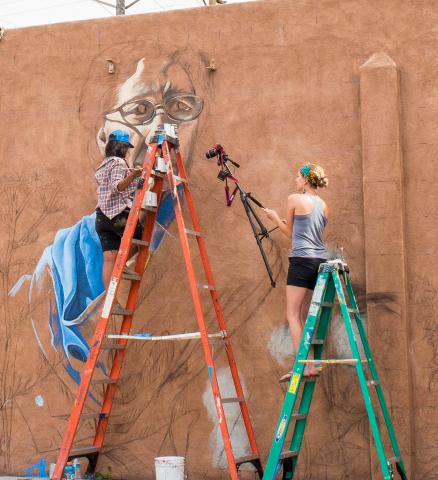Angela’s internship fieldnote #2: Filming on Site
by:
We spent the rest of our trip filming as much as possible. At 8 a.m. each morning, the first thing we did was set up our camera to capture the time lapse. I spray painted three dots in the parking lot at the location chosen for the tripod (which we have set up specifically for the time lapse) to ensure that the images captured will be as consistent as possible. Maclovia doesn’t open the store until 10 a.m., which gives us about an hour and a half to do some prep work and record different shots of Nani painting. Every morning we went over (and over, and over) our storyboard, shot lists, and interview questions which would change throughout the day as well. We found that while having a storyboard was great (and would prove critical during the editing process), it was extremely difficult to rely on a strict storyboard and shot list for the story we were trying to tell, because we didn’t know much of the story yet.

We learned that Maclovia began learning herbalism from her step-grandmother when she between the ages of 8 and 10 years old. Her family originated in Spain, but in the 1700’s five brothers took a ship to North America, settling throughout New Mexico. She has been invited as a guest at the Smithsonian, not once but twice. Maclovia married Eloy around the age of 20, and raised five children during her 30 year career as a military wife. Living all over the U.S., and caring for her family while her husband was sent overseas in two different wars, Maclovia always maintained her belief in the power of herbs to heal, and furthered her knowledge by reading on herbalism as much as she could. After Eloy’s career ended, they moved back to Albuquerque where Maclovia began working as an herbalist at B. Ruppe Drugs. She has never desired to move to a more marketable location or to expand. You will not see advertisements for her store, and from the looks outside you wouldn’t even know the treasure that lies within.
So now how can we shrink all this (and so much more) into less than five minutes for our short film? While we haven’t quite figured that out yet, we proceed with asking her as many questions as come to mind on camera, and hope that the narrative will come together as we watch the footage. We want to convey to an audience the resilience of this woman to maintain the authenticity of her small store, and see how without knowing she has become a reflection of some of her favorite medicinal plants, considered weeds. Both have been long overlooked by most people, but within they hold a secret knowledge of the power to heal, and the desire to share this secret with anyone whose mind is open and willing to listen.
We had long dinners with Nani several nights this week, losing track of time from being swept up in thoughtful conversation. We talked extensively about the presence of plants and landscape in many of Nani’s most recent works. It is clear that Nani has thought extensively over the last several years about her concern for the world the she is leaving to her son. The complicated social and environmental issues currently impacting our lives and changing our landscapes, are key components in determining our legacy. Nani tells us how inspired she is by Maclovia, and how strongly she feels that we as a society don’t value our elders for their lifetime of knowledge and experience the way that people used to, and she worries that so much indispensable knowledge and culture is slowly disappearing with that generation. As I think about Nani’s passion to communicate to her community through murals, I am feeling even more inspired that the she chooses messages seeking to improve the lives of the people in her community by protecting the landscape that has long provided for them.